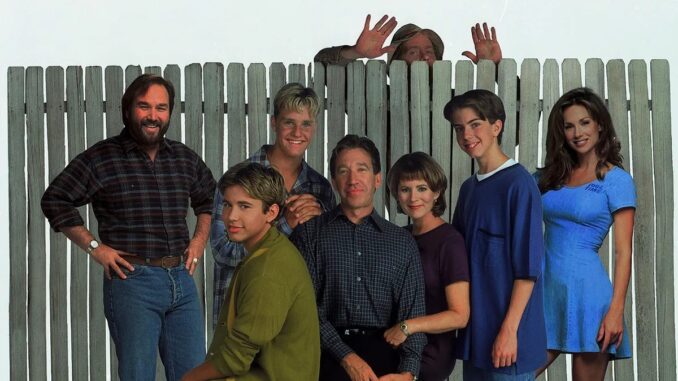
Home Improvement, the beloved 90s sitcom starring Tim Allen, had one character that always left viewers curious and intrigued—Wilson W. Wilson Jr. Played by actor Earl Hindman, Wilson was the mysterious neighbor who would give advice to Tim Taylor (Tim Allen) from behind the fence. Yet, the most striking feature of this character was that his face was always hidden, leaving us only with glimpses of his eyes, forehead, and sometimes his hands. So, why did Wilson always hide his face? Let’s take a deep dive into the story behind this intriguing mystery.
The Enigma of Wilson: A Familiar Sight on Home Improvement
Wilson’s character was an integral part of the show. As the neighbor next door, he served as a confidant, mentor, and, occasionally, a comic relief for Tim. The idea of Wilson’s face being hidden became a trademark of the show, sparking curiosity among viewers. But was there more to his face being hidden than just a quirky characteristic?
Behind the Fence: The Genesis of Wilson’s Mysterious Persona
The decision to hide Wilson’s face was initially a creative choice. In the early stages of Home Improvement, the writers and creators wanted to develop Wilson as a quirky yet wise character without giving away too much about him. Hiding his face behind the fence made him an enigma, someone who would remain a mystery to the audience throughout the show.
Why Hide His Face? The Creative Intentions Behind the Fence
The choice to keep Wilson’s face hidden was intentional and served multiple purposes. First, it created a sense of mystery and intrigue. Imagine if Wilson’s face had been fully visible from the beginning—would he have been as interesting? Probably not. By keeping the focus on his eyes, voice, and hands, the show left much to the viewer’s imagination, which added to his appeal.
Additionally, Wilson’s character was built on giving advice and offering wisdom to Tim. By keeping his face hidden, it allowed viewers to focus on his words and actions, rather than his appearance. The face became less important than his role as the sage neighbor with endless pearls of wisdom.
The Symbolism of the Fence: More Than Just a Physical Barrier
While the fence was literally a barrier between Tim and Wilson’s backyard, it also symbolized something much deeper. It acted as a metaphor for the way in which Wilson’s character served as a boundary between the “real” world of the show and the more philosophical, introspective world that Wilson represented. The fence helped maintain his role as a confidant—a character who could offer advice but remain emotionally distant.
Was There a Deeper Meaning Behind Wilson’s Hidden Face?
In a way, Wilson’s hidden face represented the idea of “hiding behind a mask.” Whether it was to maintain a sense of privacy, or to serve as a symbolic barrier, the face was intentionally concealed to convey that sometimes, the most profound connections are made without revealing everything. It was a commentary on human relationships and the idea that sometimes, it’s better to be partially hidden to foster a more intimate connection.
The Real Reason Behind Wilson’s Face: Earl Hindman’s Personal Choice

In reality, Earl Hindman, the actor behind Wilson, was not fully covered by the fence for every scene. However, the decision to keep his face hidden was also partially due to Hindman’s own preferences. He was somewhat introverted and did not want to be the center of attention like the other characters on the show. Hindman preferred the anonymity of Wilson’s role, which worked perfectly with the mysterious persona the writers had crafted for the character.
How Wilson’s Face Became a Pop Culture Icon
Over time, Wilson’s hidden face became one of the most iconic aspects of Home Improvement. Fans speculated about what he might look like, and many found themselves attached to the mystery. The running joke on the show became that viewers would never see Wilson’s full face, making him an unforgettable figure in TV history. The absence of his face made him more memorable, as it allowed the audience to project their ideas of what he might look like.
Did Tim Ever See Wilson’s Face?

As the show went on, viewers began to wonder if Tim ever got the chance to see Wilson’s face in full. The answer is yes—sort of. In the final episode of Home Improvement, the audience was finally given a brief glimpse of Wilson’s face. However, this moment was fleeting, and Wilson’s face was still mostly hidden. This kept the mystery intact while offering a small sense of closure to fans who had been eagerly waiting to see him in full.
The Lasting Impact of Wilson’s Hidden Face
Wilson’s hidden face wasn’t just a plot device. It became a key aspect of the show’s humor, character development, and overall appeal. It was a reminder that, sometimes, the best characters are the ones who don’t need to reveal everything about themselves to make an impact.
Behind the Fence: A Clever Storytelling Tool
The decision to hide Wilson’s face behind the fence was a clever storytelling technique that helped define the show’s unique charm. By creating a sense of mystery around his character, the show encouraged viewers to focus on what really mattered: the advice he gave and the wisdom he imparted to Tim. The fence acted as both a literal and figurative barrier, separating Wilson from the rest of the world while still allowing him to be an essential part of the story.
The End of the Fence: Why the Show’s Legacy Lives On
The absence of Wilson’s full face didn’t hinder Home Improvement’s popularity. In fact, it added to the show’s charm and legacy. Even years after the show ended, fans still talk about Wilson and his fence. His hidden face remains one of the most memorable and beloved aspects of the series, and it’s a testament to how clever writing and creative choices can leave a lasting impression on audiences.
Wilson’s Face and the Heart of Home Improvement

At its core, Home Improvement wasn’t just about Tim Taylor’s misadventures; it was about relationships, mentorship, and the simple wisdom shared between people. Wilson’s face may have been hidden, but his heart and soul were always visible through his advice, kindness, and unwavering support for Tim.
Conclusion: The Timeless Mystery of Wilson’s Face
Wilson’s hidden face on Home Improvement is a perfect example of how creative choices in television can have a lasting impact on the audience. What started as a simple storytelling device became an iconic part of the show’s legacy. Through Wilson, we learned that sometimes, it’s not the outward appearance that matters, but the wisdom, advice, and relationships that truly define a character. Whether behind the fence or offering sage advice, Wilson will always be remembered as one of TV’s greatest mysteries.
FAQs:
1. Why did Wilson always hide behind the fence on Home Improvement?
Wilson’s face was hidden to create mystery and intrigue. This kept viewers focused on his character’s wisdom rather than his appearance, making him more memorable.
2. Did Tim ever see Wilson’s face?
Yes, in the final episode, Tim sees Wilson’s face, but it’s only for a brief moment, maintaining the character’s mystique.
3. Was Earl Hindman, the actor who played Wilson, really behind the fence the entire time?
No, Earl Hindman wasn’t always behind the fence, but his preference for privacy made the hidden face concept work well for the character.
4. What does the fence symbolize in the show?
The fence symbolizes a boundary between the “real” world and the more philosophical, introspective world that Wilson represented.
5. What impact did Wilson’s hidden face have on Home Improvement’s popularity?
Wilson’s hidden face became an iconic element of the show, creating lasting intrigue and contributing to the series’ legacy in pop culture.
